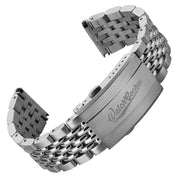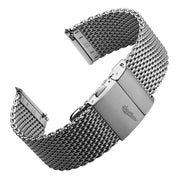Once the wristwatch took over from the pocket watch, the question of how to wear it quickly gave rise to all kinds of creative solutions. Today, we tend to group watch attachments into four main categories: leather, fabric (like military nylon straps), rubber, and metal. This guide focuses on the latter — the enduring and ever-evolving world of metal watch bands.
At a glance, a metal watch band might just seem like a metal strap. But delve a little deeper and you’ll find a whole landscape of designs, finishes, and engineering quirks — many of which have defined decades of watch design and, in some cases, made comebacks after falling out of favour.
Most bracelets are made from interlocking links that flex with the wrist, typically crafted from stainless steel, titanium, or precious metals. There are even versions in aluminium or high-grade plastic — with finishes that range from brushed to polished, and colours to suit just about any case. In this article, we’ll explore the most popular bracelet styles you’re likely to encounter today — what sets them apart, and why certain designs just never go out of style.
Oyster Bracelet

Arguably the most recognisable bracelet design in watchmaking, the Oyster is a timeless classic. Introduced by Rolex in the late 1940s, it’s a clean and sturdy three-link layout that’s since been adopted (and adapted) by countless other brands. Say “Oyster” and most watch lovers immediately picture the Submariner or Explorer — and for good reason.
Its appeal lies in its simplicity: broad, flat links that balance comfort, durability and a streamlined look. While the original Rolex version came in an all-brushed finish, many modern iterations play with contrast — polishing the centre links for a dressier vibe, or reversing the formula with polished outer edges and a brushed centre for a slightly sportier feel.
Despite its minimalism, or perhaps because of it, the Oyster remains one of the most wearable and versatile bracelet styles ever made. Whether paired with a diver, field watch or dressy daily beater, it just works.

For a modern take on the classic Oyster style, the Hylton Solid Stainless Steel Diver’s Watch Bracelet offers a robust, fully brushed finish that leans into the tool watch aesthetic. Solid end links and a secure diver’s clasp make it a strong contender for daily wear, and it’ll soon be upgraded with a custom WatchGecko buckle for that final touch of refinement.
Pros and Cons
Classic and versatile design
Durable and comfortable for everyday wear
Available in various finishes for style flexibility
Simpler design may feel less dressy for some
Polished links can show scratches more easily
H-Link Bracelet
Sitting somewhere between the ruggedness of the Oyster and the intricacy of a Jubilee, the H-link bracelet gets its name from — you guessed it — the H-shaped links that make up its design. It's a slightly more angular, structured look, often chosen for its clean symmetry and strong wrist presence.
Our Langstone Solid Stainless Steel Diver’s Watch Bracelet is a prime example. Available in both brushed and polished finishes, it offers a modern, high-quality take on the H-link format — ideal for dive watches or sportier pieces that call for something a little more distinctive than the everyday Oyster.
Pros and Cons
Bold, structured look with clean lines
Comfortable fit with strong wrist presence
Available in brushed and polished finishes
Slightly less common, so may not suit every watch style
Jubilee Bracelet

First introduced by Rolex in 1945 to mark the brand’s 40th anniversary, the Jubilee bracelet made its debut on the now-iconic Datejust — hence the name. Compared to the chunkier Oyster, the Jubilee is all about refinement: a five-link design with smaller, more flexible components that contour beautifully to the wrist.
Typically, the outer links are brushed, while the three inner links are polished for a little extra shine — though finishes vary depending on the manufacturer. What’s consistent is its reputation for comfort. Thanks to its supple structure and elegant profile, the Jubilee remains a go-to choice for those who want everyday wearability with a dressier edge.
For a refined, high-quality option in this style, the WatchGecko Warrington Stainless Steel Watch Strap features polished centre links and a brushed outer finish — a classic look that brings instant character to everything from vintage dress watches to modern GMTs.
Pros and Cons
Elegant, dressier appearance
Extremely comfortable with flexible links
Great for both vintage and modern watches
More intricate design can require careful cleaning
Milanese (Mesh) Bracelet

Originally developed in Milan in the 19th century, the Milanese — or mesh — bracelet brings an old-world craftsmanship to modern watch design. Often likened to chain mail (and sometimes called shark mesh), its tightly woven metal links create a smooth, flexible surface that hugs the wrist with surprising comfort.
Despite its tough, almost industrial look, the Milanese bracelet wears light and breathable. Some still worry about hair-pulling, but most modern versions — especially those with fine micro-links — are far gentler than their medieval appearance suggests.
WatchGecko offers a range of Milanese options to suit different tastes: the Merriott Quick-Release for effortless strap changes, the Classic Milanese Mesh, and the distinctive Oblique Milanese Mesh, which introduces a subtle diagonal twist to the traditional weave. Each brings a refined, vintage-adjacent feel to dress watches, minimalist pieces, or anything that benefits from a touch of elegance without going full formal.
Pros and Cons
Lightweight and breathable
Smooth, flexible fit that hugs the wrist
Stylish vintage-inspired look
Some may find early mesh designs pinch or pull hairs (modern versions are improved)
Beads of Rice Watch Bracelet

A true vintage classic, the Beads of Rice bracelet traces its roots back to the mid-20th century, most notably through designs by Gay Frères in the 1940s and ’50s. Its name comes from the distinctive polished centre links, which resemble tiny grains of rice nestled between broader brushed outer links — not unlike a dressier cousin to the Jubilee.
Originally favoured for its comfort and elegant drape, the style has seen a strong resurgence in recent years, especially among fans of vintage reissues and mid-century dress watches. Its flowing, multi-link design conforms beautifully to the wrist and adds an unmistakable old-school charm.
WatchGecko’s Premium Stainless Steel Beads of Rice Watch Bracelet revives that heritage look with modern build quality, offering a balanced mix of polish and brushed finishes that pairs beautifully with vintage-inspired chronographs, divers, and classic field watches.
Pros and Cons
Classic vintage charm with polished detail
Very comfortable due to multi-link construction
Pairs well with dress and casual watches
More delicate appearance may feel less sporty
President Bracelet
The President bracelet is all about prestige. Instantly recognisable by its semi-circular three-piece links, this design was created by Rolex specifically for the Day-Date, which debuted in 1956. Its nickname was cemented in 1965, when U.S. President Lyndon B. Johnson was photographed wearing a solid yellow gold Day-Date — and the “President” name has stuck ever since.
Unlike sportier styles, the President bracelet is reserved exclusively for Rolex’s most prestigious models, often crafted in precious metals. Today, it remains a symbol of luxury and influence — and unsurprisingly, original examples command eye-watering sums on the pre-owned market.
Pros and Cons
Iconic luxury design with prestige appeal
Comfortable semi-circular links
Exclusively crafted in precious metals
Typically reserved for high-end watches only
Integrated Bracelet
The integrated bracelet — where the case and bracelet flow seamlessly into one continuous form — is back in a big way. Originally popularised in the 1970s by legendary designer Gérald Genta, who gave us the Audemars Piguet Royal Oak and Patek Philippe Nautilus, the style has once again captured the imagination of both luxury brands and accessible watchmakers alike.
Whether fully integrated or using a semi-integrated end link (as seen on the hugely popular Tissot PRX), this design trend is all about bold geometry, sharp transitions, and a sleek wrist profile. Recent examples like the Christopher Ward The Twelve, Oris ProPilot X, Czapek Antarctique, Girard-Perregaux Laureato, and Bremont H1 Generation all nod to that retro-futuristic charm — blending vintage influence with modern engineering.
Once seen as a niche throwback, the integrated bracelet is now a staple of modern collections across nearly every price point — and it shows no signs of slowing down.
Pros and Cons
Seamless, modern look with bold geometry
Often lightweight with a sleek profile
Strong retro-modern appeal
Limited interchangeability with other straps
Expansion Bracelet
While we don’t stock these at WatchGecko, expansion bracelets deserve a mention for their unique practicality and vintage charm. Popular through the mid-20th century, these bracelets feature steel links joined with an elastic mechanism that allows the strap to stretch and slip easily over the wrist — no fiddling with clasps or buckles.
Perfect for quick on-and-off wear, expansion bracelets do have their downsides: over time, the elastic stretches out, losing tension, and they often require careful adjustment to fit comfortably again. Not to mention, they’ve earned a notorious reputation as hair pullers. Still, they remain a fascinating part of bracelet history and an occasional collector’s favourite.
Pros and Cons
Easy to slip on and off without fiddling
Comfortable fit without clasps
Elastic can stretch over time
Requires maintenance to keep secure fit
Reputation for hair pulling
Butterfly Clasp Bracelet
The defining feature of a butterfly clasp is its symmetrical, dual-fold design that opens from the middle, offering a sleek and balanced closure. At WatchGecko, our standout example is the German Butterfly Mesh bracelet — a polished, premium mesh strap with this elegant clasp that ensures both security and style.

While there are many clasp types out there — from tang buckles to folding deployants and butterfly deployants — we’ll save that deep dive for another time. What’s exciting today is how brands like Tudor, Formex, and Bremont are pushing innovation further with proprietary micro-adjust systems and quick-release mechanisms, making it easier than ever to get the perfect fit and swap straps without tools.

Pros and Cons
Symmetrical design offers a sleek, balanced look
Opens smoothly from the middle for easy wear
Provides a secure and comfortable fit
Slightly more complex mechanism may require care
Can add a bit of thickness compared to simpler clasps
Ultimately, metal bracelets offer a diverse range of styles and finishes to suit any watch and wearer — blending tradition with modern innovation to deliver both comfort and timeless style. Whether you prefer the rugged simplicity of the Oyster, the elegant sophistication of the Jubilee, or the sleek modernity of an integrated bracelet, there’s a metal option to match your personality and watch choice.
Advances in clasp technology and materials mean these bracelets aren’t just about looks; they’re designed for ease of use, durability, and a perfect fit. From vintage-inspired beads of rice to lightweight Milanese mesh, metal bracelets continue to evolve while honoring their rich heritage, making them a lasting favourite in the world of horology.
Read: Everything You Need to Know About Metal Watch Bracelets and Straps












